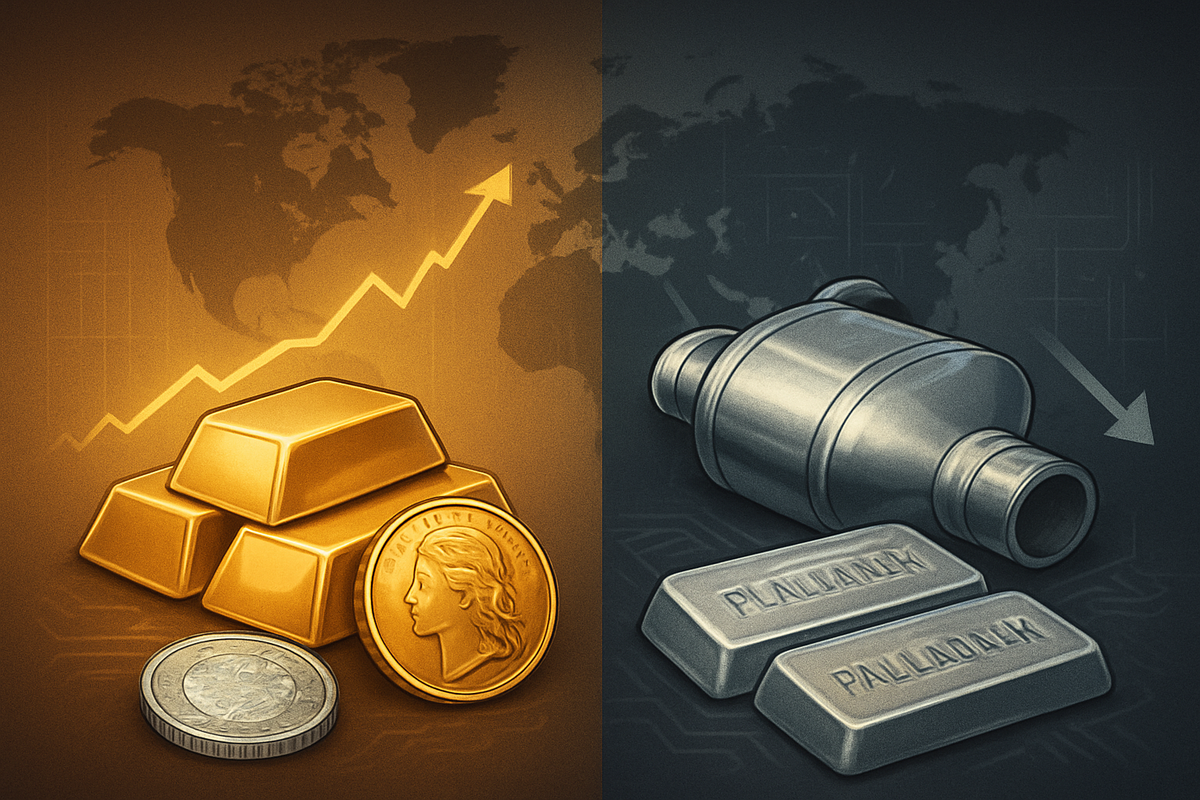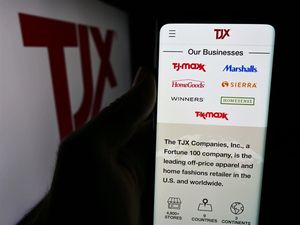
In a financial landscape increasingly defined by volatility and uncertainty, gold and silver have emerged as undeniable beacons of stability, their prices surging to multi-year highs and attracting robust investor interest. As of November 2025, these traditional safe-haven assets are demonstrating their enduring appeal, buoyed by a complex interplay of persistent global economic uncertainties and escalating geopolitical tensions. This bullish sentiment for gold and silver stands in stark contrast to the more nuanced and challenging environment faced by their platinum group metal (PGM) counterparts, platinum and palladium, which are grappling with evolving industrial demands and structural shifts in key sectors.
The current market dynamic reflects a profound re-evaluation of hard assets, with investors seeking refuge from inflationary pressures, a weakening U.S. dollar, and the specter of global economic slowdowns. Silver, in particular, has seen an explosive rally, not only benefiting from its safe-haven status but also from its burgeoning role in the green energy transition and advanced technologies. This divergence in performance underscores a critical juncture for the precious metals market, signaling a recalibration of fundamental drivers and presenting both significant opportunities and formidable challenges for market participants.
A Tale of Two Markets: Gold and Silver Soar, PGMs Face Realignments
The year 2025 has been nothing short of extraordinary for gold and silver, solidifying their roles as essential portfolio diversifiers. Gold (XAU) has seen an impressive surge, breaching the psychologically important $3,000 per ounce threshold in March and continuing its ascent to surpass $4,000 per ounce by October, even touching peaks near $4,400. As of mid-November 2025, spot gold trades robustly between $4,080 and $4,130 per ounce, marking a significant 17.4% year-to-date gain. This rally is primarily driven by persistent inflation concerns, fears of economic instability, ongoing geopolitical conflicts (such as in Ukraine and the Middle East), a weakening US Dollar, and unprecedented central bank demand, particularly from emerging markets diversifying away from the dollar.
Silver (XAG), often dubbed "poor man's gold," has not only mirrored gold's upward trajectory but, in many respects, has outshone it. By September 26, silver reached its highest level in 14.5 years at $45.23 per ounce, and by mid-November, prices were hovering around $50.50 to $52.10 per ounce, with some aggressive forecasts predicting $60-$75 by year-end. Silver's stellar performance is fueled by its dual nature: its traditional safe-haven appeal and an explosion in industrial demand. The renewable energy sector, especially solar panel manufacturing, is a massive consumer, alongside its critical role in electronics, semiconductors (5G, AI, IoT), and electric vehicles (EVs). The market has also faced its fifth consecutive year of significant supply deficits, with demand consistently outstripping mine production, creating a powerful catalyst for price appreciation. The U.S. officially classifying silver as a "critical mineral" in November 2025 further underscores its strategic importance.
In stark contrast, platinum (XPT) and palladium (XPD) have experienced a more complex narrative. Platinum delivered an extraordinary performance in the first half of 2025, surging by an impressive 40% in just six months and accelerating dramatically in Q2 with a 36% soar. By July 14, platinum had surged around 60% year-to-date, reaching $1,661 per ounce by November 17, representing a 66.83% increase since the start of the year. This resurgence is largely due to a structural supply deficit, estimated at nearly one million troy ounces for 2025, primarily from South Africa, and growing industrial demand across automotive (especially hybrid vehicles and substitution for palladium), hydrogen technologies, and jewelry. However, easing supply pressures and potential demand suppression from high prices are moderating factors.
Palladium's market in 2025 has been characterized by a surprising resurgence despite long-term structural headwinds. It surged as much as 41% year-to-date, peaking around $1,655 per ounce in mid-October. However, November saw notable short-term dips, with prices around $1,442 per ounce by November 19. The primary headwinds for palladium are the accelerating shift towards electric vehicles, which do not use palladium in catalytic converters (accounting for over 80% of its demand), and the increasing substitution of palladium with less expensive platinum in these devices. Forecasts indicate a transition into a market surplus, signaling a cautious long-term outlook despite initial supply constraints and geopolitical risks providing some early-year support.
Public Companies Navigate the Precious Metals Divide
The diverging fortunes of gold, silver, platinum, and palladium have profound implications for public companies operating within the precious metals sector. Companies heavily invested in gold and silver mining are poised for significant gains, while those with substantial exposure to palladium face strategic challenges.
Leading gold producers are direct beneficiaries of the metal's ascent. Newmont Corporation (NYSE: NEM), the world's largest gold producer, has demonstrated strong financial performance, exceeding analyst expectations and seeing its stock up an impressive 80% year-to-date in August 2025. Barrick Gold Corporation (NYSE: GOLD) is another top gold mining stock appealing to investors due to its operational scale and disciplined approach. Similarly, Agnico Eagle Mines Limited (NYSE: AEM) offers diversification with low-risk operations and a balanced gold-silver output. These companies are experiencing robust cash flows, enabling increased exploration budgets, potential development of new deposits, and a focus on expanding production in stable jurisdictions. Their stock performance is often a leveraged play on metal prices, amplifying returns during bull markets.
Silver-focused companies are also thriving. Pan American Silver Corp. (NASDAQ: PAAS), one of the largest silver producers, benefits from geographic diversity and exposure to both silver and gold, delivering 48% gains over the past year. Wheaton Precious Metals Corp. (NYSE: WPM), a streaming company, provides a lower-risk exposure to silver and gold, purchasing metals from other miners at fixed costs, ensuring consistent margins, and returning 54% in the last year. MAG Silver (NYSE: MAG), with its focus on high-grade silver projects, has seen its stock surge 40%. Royalty and streaming companies like Franco-Nevada (NYSE: FNV), Royal Gold (NASDAQ: RGLD), Osisko Gold Royalties (NYSE: OR), and Sandstorm Gold (NYSE: SAND) are also well-positioned, offering leverage to rising metal prices with comparatively lower operational risks. These "winners" are likely to prioritize optimizing existing operations, engaging in strategic M&A, and returning capital to shareholders through dividends and buybacks.
Conversely, companies with significant exposure to palladium are facing considerable headwinds. Nornickel (MCX: GMKN), the world's largest palladium producer, faces geopolitical risks due to its Russian base and ongoing sanctions, contributing to price volatility. Diversified PGM producers like Impala Platinum Holdings Limited (JSE: IMP) and Sibanye-Stillwater (NYSE: SBSW) will see their palladium segments challenged. Anglo American Platinum (JSE: AMS), a global leader in PGM production, faces headwinds from declining palladium prices, higher deep-level mining costs, and operational disruptions in South Africa. These companies are likely to experience pressure on revenues and margins, leading to cost-cutting, slower expansion, and potentially a re-evaluation of palladium-heavy assets. Diversification into other metals, like Sibanye-Stillwater's interest in lithium, could become a key strategic imperative to mitigate risks associated with the long-term decline in palladium demand.
Broader Implications and Historical Echoes
The current precious metals market dynamics are not isolated events but rather integral to broader industry trends and global economic shifts. The sustained demand for gold and silver as safe havens underscores a pervasive lack of confidence in traditional financial assets amidst persistent inflation, rising global debt, and geopolitical fragmentation. This trend aligns with historical precedents where gold and silver have consistently served as hedges during periods of economic downturns, high inflation (e.g., the 1970s oil shocks), and geopolitical instability.
The unprecedented level of central bank gold accumulation, particularly from non-Western nations, signals a strategic diversification away from the U.S. dollar and a move towards a multi-polar reserve system. This "de-dollarization" effort has significant ripple effects, potentially influencing currency markets and global trade dynamics in the long term.
For platinum and palladium, the story is one of industrial transformation. The accelerating global push towards decarbonization and electrification is a double-edged sword. While it creates immense demand for silver in solar panels, EVs, and electronics, and for platinum in hydrogen fuel cells and as a substitute for palladium, it presents an "existential threat" to palladium's dominant role in internal combustion engine catalytic converters. This shift will ripple through the automotive industry, which will benefit from lower palladium input costs but must also adapt to evolving PGM prices and potential supply chain disruptions, especially as platinum gains prominence.
Regulatory and policy implications are also significant. Central bank monetary policies, particularly the Federal Reserve's stance on interest rates, remain powerful market signals. Expectations of rate cuts generally bolster precious metals, while hawkish shifts strengthen the dollar. Trade policies, including potential tariffs, can directly impact industrial demand and supply chains for these metals. Furthermore, the London Metal Exchange's (LME) decision to cease platinum and palladium benchmark auctions by mid-2026 signifies a strategic realignment for market participants, requiring adaptation to new pricing mechanisms and potentially impacting liquidity.
What Comes Next: A Dynamic Future for Precious Metals
Looking ahead to late 2025 and into 2026, the precious metals market is poised for continued dynamism, with distinct trajectories for each metal.
For gold, the short-term might see some consolidation after its recent highs, but the long-term outlook remains overwhelmingly bullish. J.P. Morgan Research expects gold to average $3,675/oz by Q4 2025 and climb towards $4,000 by mid-2026, with more optimistic projections from Goldman Sachs and UBS suggesting $4,900-$5,000 by the end of 2026 or 2027. Persistent geopolitical instability, continued central bank accumulation, and expectations of central bank interest rate cuts will be key drivers.
Silver is forecast to continue its strong performance, with many analysts expecting it to outperform gold. Forecasts for 2026 vary, with some predicting averages of $45-$60/oz, while others project it to reach $75 by the end of 2026 and potentially $100 per ounce by 2030. This growth is underpinned by steady or rising deficits from green technology demand spikes (solar, 5G, chips), potential central bank additions to silver reserves, and strong investment flows.
Platinum is also expected to maintain its upward trend. Metals Focus forecasts an average platinum price of US$1,670 per ounce in 2026, up 34% over the previous year, with some predictions indicating it could climb to $2,400 by the end of 2026 and $2,500 by mid-2027. Continued supply deficits, increased industrial demand (especially for hydrogen fuel cell technology), and growing interest from the jewelry sector will fuel this growth.
The future for palladium is more uncertain. While some forecasts suggest an increase to $1,500 by the end of 2025 and $1,752 in the first half of 2026, others are more bearish, predicting it could drop to $1,150 by Q4 2026. The primary challenge remains its heavy reliance on the automotive sector and the accelerating shift towards electric vehicles and platinum substitution. Companies heavily reliant on palladium will need to implement aggressive cost-cutting measures, explore diversification, and invest in new technologies to remain competitive.
Strategic pivots for companies across the sector include prioritizing ESG integration, leveraging digital transformation and AI for operational efficiency, and diversifying portfolios to include battery minerals and critical rare earths. Market opportunities lie in the green energy transition, continued safe-haven demand, and central bank buying. Challenges include commodity price volatility, rising operational costs, resource depletion, and regulatory scrutiny.
The Enduring Value of Hard Assets: A Market Minute Wrap-up
The precious metals market in November 2025 underscores a fundamental truth: in times of uncertainty, hard assets retain their allure. Gold and silver have reaffirmed their roles as indispensable safe havens, their robust performance reflecting deep-seated concerns about global economic stability, inflation, and geopolitical risks. Silver's dual nature, combining monetary appeal with surging industrial demand from the green energy revolution, positions it for potentially explosive long-term growth. Platinum, despite some near-term volatility, is carving out a strong niche fueled by structural supply deficits and its increasing role in new energy technologies and as a substitute for palladium.
Palladium, however, stands at a crossroads. While exhibiting surprising resilience in 2025, the long-term structural headwinds from the electric vehicle transition and platinum substitution present significant challenges that will require profound strategic adjustments from producers.
Moving forward, investors should anticipate continued volatility but within a broader bullish trend for gold, silver, and platinum. The market is undergoing a healthy consolidation, offering potential "buy on dips" opportunities for long-term holders. The enduring significance of these metals extends beyond mere investment; they are becoming strategic components of national economic resilience and technological advancement.
What Investors Should Watch For:
- Federal Reserve Monetary Policy: Closely monitor interest rate decisions and forward guidance, as these will significantly influence non-yielding assets.
- Geopolitical Developments: Any escalation or de-escalation of global conflicts and trade tensions will impact safe-haven demand.
- Inflation Data: Persistent inflation will continue to support gold and silver as hedges.
- Industrial Demand Trends: For silver and platinum, keep an eye on developments in renewable energy, AI, and the automotive sector.
- Platinum/Palladium Price Spread: Observe the ongoing substitution rates in catalytic converters, which will dictate their relative performance.
- Central Bank Activity: Continued gold purchases by central banks will provide a strong demand floor.
This content is intended for informational purposes only and is not financial advice





